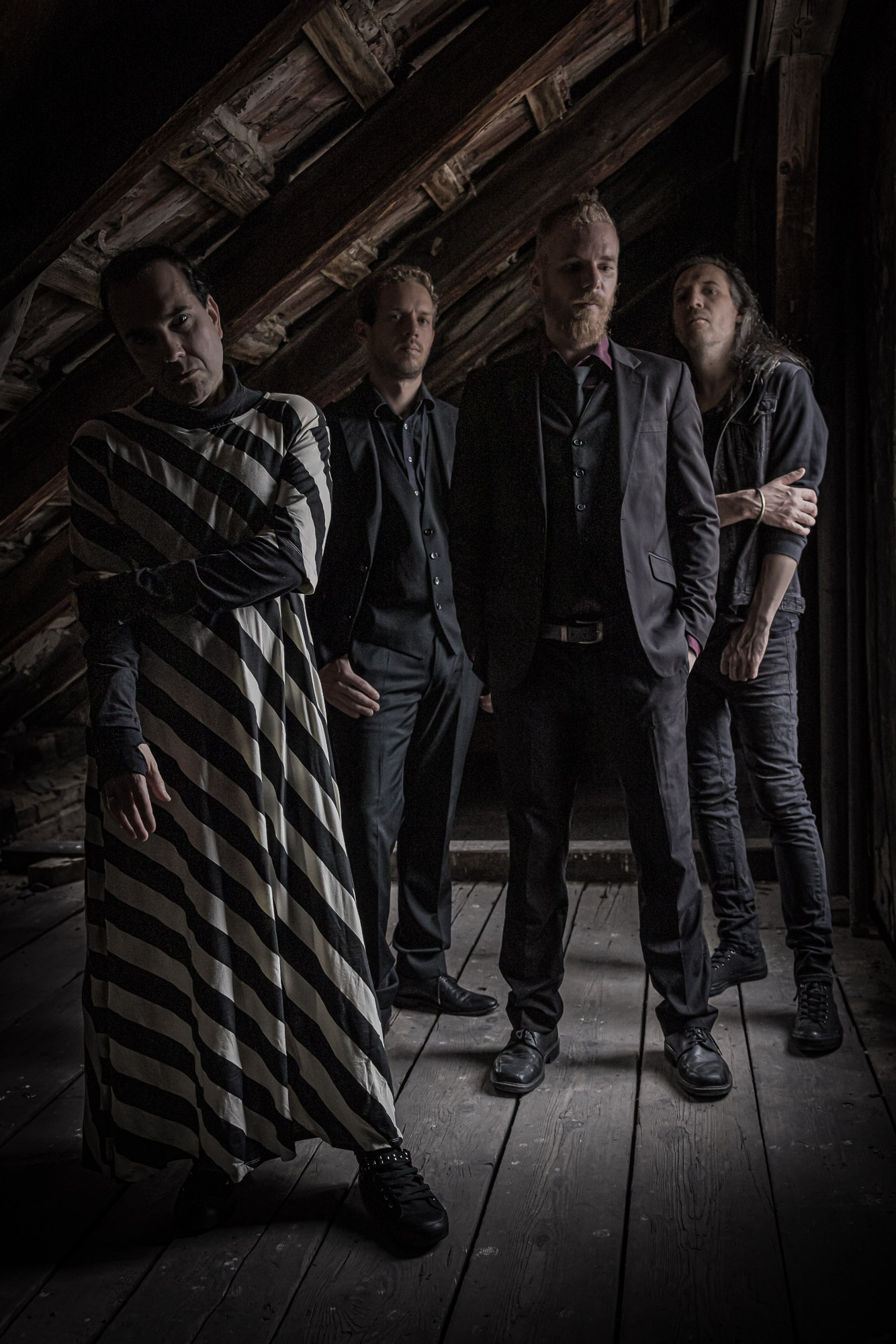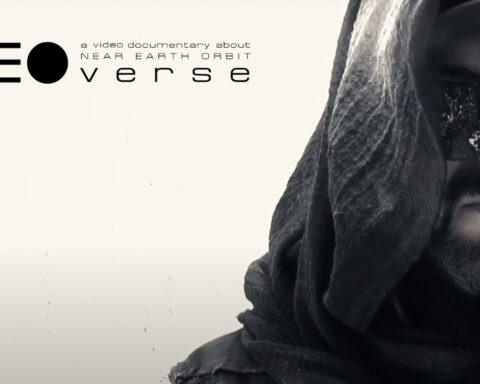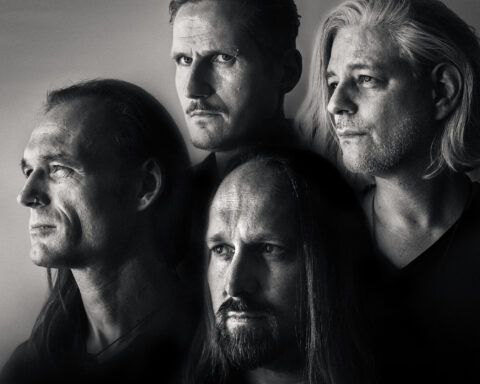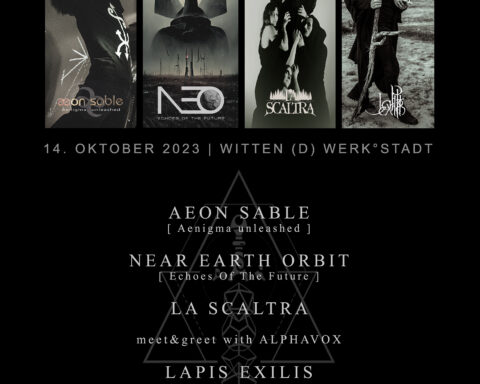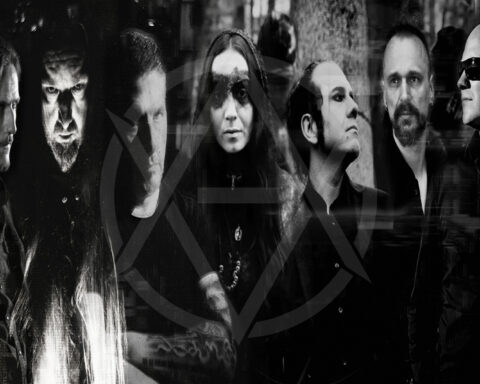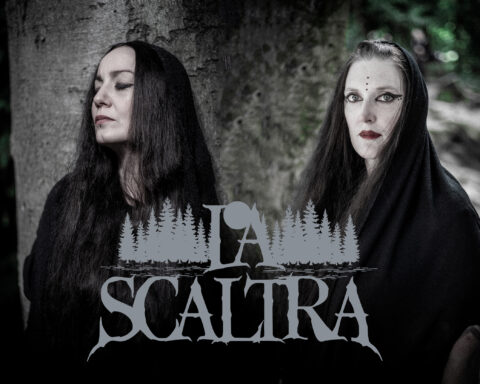WHISPERS IN THE SHADOW, Österreichs dienstälteste Gothic-Band, legen mit GHOSTS ihr elftes Studioalbum vor. Welche Geister sie besingen, warum sich auf dem Album keine Spur von Altersmilde findet und welcher Podcast aktuell der Beste ist, erzählt Frontman Ashley Dayour im Interview.
Hallo Ashley,
danke, dass du dir für dieses Interview Zeit nimmst. Die erste Frage, die mir in den Sinn kam, als ich das Album zum ersten Mal angehört habe, ist: Gehts dir gut? Hahaha, ja alles bestens, danke der Nachfrage. Das Album ist schon ein ziemliches Monstrum und bei einigen Stellen kann einem schon etwas angst und bange werden. Und tatsächlich behandelt es durchaus auch persönliche Themen, daher ist die Frage nicht ganz unbegründet. Die Zeit, in der es entstand, oder sagen wir eher die Zeit davor, hatte schon seine durchwachsenen Phasen, aber wir haben es gut zu Ende gebracht.
Das Album ist für die WITS-Verhältnisse sehr heavy, fast schon Whispers-Metal. Tiefer gestimmte Gitarren treffen auf donnerndes Schlagzeug und dröhnenden Bass. Wieso habt ihr nach 27 Jahren Bandbestehen diese Richtung eingeschlagen? Da wir auch nach 27 Jahren immer noch auf der Suche sind und unseren bandeigenen Sound-Kosmos erweitern wollen, erschien mir das ein guter und spannender Weg. Eine gewisse Heaviness haben wir zwar in der Vergangenheit schon immer wieder anklingen lassen, ich denke z. B. an Songs wie BABYLON RISING oder DOWN BY THE SEA (2008, INTO THE ARMS OF CHAOS), aber noch nie so konsequent und doomy. Das Album hat allerdings zwei Seiten, zum einen eben diese harten Gitarren-Songs, aber es gibt auch wavige Stücke, aber selbst die haben eine gewisse Schwere. Es erschien mir reizvoll, nach dem verspielten kaleidoskopartigen, ja mitunter auch recht eingängigem letzten Album wieder etwas dunkleres und schweres zu machen.
[ENGLISH BELOW]
Normalerweise geht man mit zunehmendem Alter von Altersmilde aus. Auf GHOSTS dröhnt einem aber einerseits Wut entgegen und andererseits diese düstere Schwere, die du gerade angesprochen hast. Liegt das an dem aktuellen Weltgeschehen? Als Künstler wird man ja, ob man es möchte oder nicht, von seiner Umwelt beeinflusst. Ich bin der Meinung, dass ein großer Teil der Kreativität sich von dem nährt, was C.G. Jung das kollektive Unbewusste genannt hat, obwohl das Album – anders als die Letzten – thematisch etwas kryptischer und auch persönlicher ist. Altersmilde kann man dem Album tatsächlich nicht unterstellen. Es war dann doch noch etwas zu früh für unser ruhiges Akustik-Album, auf dem wir zurückschauen und über alles nachdenken. Noch sind wir nicht ganz ergraut und introspektiv geworden.
Wie seid ihr an die Produktion von GHOSTS rangegangen? Du und Keyboarder Martin “Acid” Gutmann habt das Album zusammen produziert. Wie kann man sich eure Arbeitsweise vorstellen? Ich schreibe die Songs in meinem Homestudio fix und fertig, erstelle das Arrangement, die Texte und habe in etwa eine Vorstellung, wo es soundmäßig hingehen soll, was sich aber durchaus im Laufe einer Produktion ändern kann. Martin kümmert sich dann um die Recordings, betreut die eigentlichen Aufnahmen der Instrumente und ist mir mit seinem Feedback eine sehr große Hilfe beim Einsingen der Songs. Dann fertigt er die ersten Mixe an, ich gebe meinen Input dazu und am Ende haben wir eine Version, die dem entspricht, was der Song von uns will. Diesmal haben wir im Studio sehr viel experimentiert und dekonstruiert. Die fertige Version von GHOST LOOP REMEDY hat sich z. B. weit von dem entfernt, was der Song ursprünglich war. Der Sound der Platte hat sich diesmal erst nach und nach im Studio entwickelt und gerade was die Gitarren-Sounds angeht, haben wir diesmal sicher keine Gefangenen genommen und wild experimentiert mit allerlei Effekt-Geräten.
Ich gehe mal davon aus, dass mit “Ghosts” eher Geister im übertragenen Sinne gemeint sind. Bevor wir aber darüber sprechen, machen wir einen kurzen Exkurs, denn mich interessiert deine persönliche Meinung zu Geistern im wörtlichen Sinne. Ich habe auf Facebook ein Foto von dir gesehen, auf dem du ein T-Shirt des BBC-Podcasts „Uncanny“ trägst. In dem geht es um paranormale Phänomene. Wie stehst du persönlich dazu? Bist du Team Skeptic oder Team Believer? Ich liebe Uncanny, meines Erachtens einer der besten Podcasts, die es gibt. Sehr unterhaltsam, witzig und eine wirklich gute Produktion. Geht ja in England auch gerade richtig durch die Decke. Zurecht! Nun, ich glaube weder noch, ich habe mich da noch nicht festgelegt, tendiere aber grundsätzlich schon eher zu Team Skeptic. Es gibt viel Unsinn auf dem Gebiet und es ist eher so, dass man mich erst mal überzeugen muss, meine Ausgangssituation ist die eines Skeptikers. Es liegt auch immer an dem jeweiligen Fall an sich.
Im Booklet zitiert ihr Libba Bray. “Every city is a ghost. New buildings rise upon the bones of the old so that each shiny steel beam, each tower of brick carries within it the memories of what has gone before, an architectural haunting.” Wie muss man sich die Geister der Moderne vorstelle, wo findet man sie und wie? Ich glaube noch nie war die Gegenwart so vernarrt in die Vergangenheit wie heutzutage. Die Geister sind also überall. In gewissem Sinne sind wir alle Geisterjäger bzw. sind wir sogar selbst zu Geistern geworden, die die Vergangenheit immer wieder reproduzieren wollen und das auch tun. Wiedergänger. Darum dreht sich auch der Song REVENANTS (zu Deutsch Wiedergänger) in dem es heißt „We are revenants, haunted by a future that never was“.
Lass uns über die andere Art von Geistern reden. Kannst du ein paar Beispiele nennen, welche Geister in den Texten herumspuken? Süchte, Paranoia, Egomanie, Ängste und Zwänge und vor allem der schlimmste Geist von allen, die Angst vor der Angst. Dieses Album ist in weiten Teilen eine Reise durch den Abyss. Eine Beschäftigung mit den eigenen und den kollektiven Schattenseiten.
Im Gegensatz zu anderen WITS-Alben handelt es sich bei GHOSTS nicht um ein Konzeptalbum. Was für Themen behandelt ihr noch? Ich bin mir gar nicht sicher, ob es nicht doch ein Konzept-Album geworden ist. Vielleicht auf eine andere, nicht so offensichtliche Art und Weise. Es gibt zwar keine Story oder einen Faden, der sich durchzieht, aber schlussendlich ist es ein Werk geworden, das mehr in sich geschlossen ist als das letzte Album. Was jetzt keine Kritik an YESTERDAY IS FOREVER ist, das Album war ja auch als Kaleidoskope zu verstehen, jeder Song ein Kosmos für sich. Auf GHOSTS ergeben die Songs trotz unterschiedlicher Instrumentierung eine durchgehende Atmosphäre.
Als wir uns 2020 über Optimismus unterhalten haben, nanntest du WITS eine “furchtlose Band”. Jetzt thematisiert ihr auf GHOSTS aber auch Angst und die Angst vor der Angst. Inwiefern passt das zusammen? Furchtlos zu sein heißt ja nicht keine Angst zu haben, sondern sich ihr zu stellen. Kann man ohne Angst überhaupt furchtlos sein?
Spannend, so hab’ ich das noch nie gehört. Furchtlos hat für mich bisher immer bedeutet, keine Angst zu haben, aber ich lass das jetzt mal so stehen. Mein persönlicher Lieblingssatz des Albums ist: „Stop the press, that’s not the story I want to tell“. Ein relativ simpler Satz, aber du singst ihn mit so einer Dringlichkeit. Und das kennt wohl jede/r, dass man am Ende ganz woanders landet als geplant. Das ist manchmal von Vorteil, aber manchmal verzettelt man sich auch und biegt falsch ab. Wie oft ist dir das beim Songwriting dieses Albums so gegangen? Das ist tatsächlich auch eine meiner liebsten Passagen auf dem Album. Das Songwriting war diesmal ein harter Brocken. Ich habe sehr viel angefangen und wieder weggeworfen. Gut, das mach ich immer, aber diesmal war es irgendwie schwieriger. Es hat einfach gedauert rauszufinden, wie dieser heavy Sound innerhalb unseres eigenen Kosmos überhaupt Sinn macht. Und natürlich heißt es bei einem Stilwechsel ja auch erst mal rauszufinden, welche Sounds es braucht, wie man solche Songs schreibt etc. Da gab es schon einige Fehlstarts und ich habe mehrmals daran gezweifelt, ob das alles eine gute Idee war. Ich kann nicht sagen, dass ich dabei immer Spaß hatte, aber darum geht es ja auch nicht zwingend. Am Ende zählt der Song/das Album und mit dem muss man zufrieden sein. Ich will aber auch nicht zu viel rumjammern, das gehört einfach zum Job und manchmal ist es eben einfacher und manchmal ist es schwerer. Aber natürlich könnten wir es uns auch wesentlich einfacher machen, keine Frage.
2008 bis 2014 habt ihr einen 4-Alben-Okkult-Zyklus veröffentlicht und auch deine andere Band The Ðevil & The Uñiverse wird vom Okkultismus inspiriert. Haben diese Themen auch Eingang in GHOSTS gefunden oder gehört das für dich der Vergangenheit an? Textlich sind diese Themen wesentlich präsenter als auf den letzten Alben, aber auf eine andere, weniger offensichtliche und wohl auch persönlichere Weise, als das früher der Fall war. Ich verfüge jetzt über andere Sichtweisen und Erfahrungen, die die Jahre dazwischen gebracht haben.
Ich merke schon, du hältst dich da eher bedeckt. Wo wir gerade beim Thema sind. Grafiker Billy Phobia hat für das Cover die magische Technik des Automatischen Zeichnens verwendet. Wie kann man sich das vorstellen? Die Technik des Automatischen Zeichnens wurde von den Surrealisten entwickelt, um Unbewusstes auszudrücken und zu enthüllen, was sonst versteckt unter der Oberfläche bleibt. Gezeichnet wird möglichst frei von rationaler Kontrolle. Der Verstand soll sich raushalten, während die Hand intuitive und zufällige Bewegungsspuren auf dem Papier hinterlässt. Es wird frei von Regeln und Konventionen aus dem Inneren heraus gezeichnet. Das Cover hat Billy zur Musik gezeichnet, er ließ sich von den Sounds leiten. Ich bin sehr zufrieden mit dem Ergebnis und halte es für eines der schönsten und stimmigsten Cover der Bandgeschichte. Ich bin Billy sehr dankbar dafür, er hat sich selbst übertroffen.
Das Herzstück des Albums ist das 13-minütige MAJESTY & TORMENT, eine Art Rockoper. Schon früher habt ihr lange Songs veröffentlicht, ich denke da z.B. an DOWN BY SEA, das du vorhin auch schon erwähnt hast. MAJESTY & TORMENT ist aber überraschend progressiv. Was waren deine Beweggründe, diesen Song zu schreiben und warum hast du dafür diese Form für ihn gewählt? Vielleicht ist dieser Song so etwas wie das musikalische Pendant zum Automatischen Zeichen? Auf jeden Fall kann ich sagen, dass mir dieses Monster einfach so passiert ist. Es ist eine Reise durch den Abgrund und mit Sicherheit unser progressivster Song mit all seinen Takt-, Stimmungs- und Tempo-Wechsel. Tatsächlich so etwas wie das Kernstück des Albums. Die Arbeit daran hat sehr lange gedauert, fast die Hälfte des ganzen Songwriting-Prozesses, wenn ich so darüber nachdenke.
Mit A HAUNTING habt ihr als Singleauskopplung einen Song ausgewählt, der eine Brücke zu den Bandanfängen schlägt, aber auch an WALK ON THE MIRROR von YESTERDAY IS FOREVER anknüpft. Gleichzeitig erscheint er mir aber in seiner Ruhe und atmosphärischen Stimmung nicht unbedingt repräsentativ für das restliche Album. Warum habt ihr euch dennoch für ihn als Single entschieden? Ja, das Stück kann einen schon in die Irre führen, was das Album angeht. Wobei es mit GHOST LOOP REMEDY zumindest einen weiteren Song gibt, der eine ähnliche Richtung einschlägt. Wie schon WALK ON THE MIRROR zeigt er uns musikalisch von einer, ich nenne es mal „romantischeren Seite“, die man bei uns nur selten findet. Diese Art von Songs ist sehr heikel, und es bedarf einer gewissen Balance, damit sie funktionieren. Ich halte ihn für den eingängigsten Track auf dem Album und wohl der einzige Song, der wirklich als Single geeignet war. Thematisch dreht er sich grob gesagt um Süchte. Also nicht wirklich ein romantisches Thema, aber ich fand den Gegensatz sehr schön. Und da der Song teilweise aus Sicht der Droge gesungen wird, fand ich das auch passend. Tatsächlich könnte man A HAUNTING thematisch als so was wie die Kehrseite von WALK ON THE MIRROR sehen, das ja durchaus einen sehr verklärten Ansatz hatte, was das angeht. MIRROR ist die Sonnenseite, der Trip und A HAUNTING ist der Kater und das, was danach kommt und was passiert, wenn man diesen Weg zu weit und zu lange geht.
Was kannst du uns über den Entstehungsprozess des dazugehörigen One-Shot Videos erzählen? Ein One-Shot-Video stand schon lange auf unserer Agenda und A HAUNTING hat perfekt dazu gepasst. Außerdem hatten wir mit Andreas Horvath diesmal einen Kameramann, der es geschafft hat, unsere Ideen auch technisch so umzusetzen wie wir uns das erdacht hatten. Generell benötigte das Video im Vorfeld viel Planung, da jeder genau wissen musste, was er/sie zu tun hat. Regisseurin Edie Calie und ich haben ein Storyboard mit genau getimtem Ablauf verfasst. Der Dreh selbst ging dann sehr schnell. Die drei Darsteller/innen in den Morphsuits repräsentieren drei Geister: Paranoia, Angst und Sucht, die den Protagonisten durch den Wald jagen. Es gibt aber eine Art Happy End. Wir haben zu dem Video sehr viel gutes Feedback erhalten, gerade was die künstlerische Komponente angeht.
Autor Clay McLeod Chapman hat auf seinen Social-Media-Kanälen gepostet, dass A HAUNTING von seinem Buch GHOST EATERS inspiriert ist. Sowohl im Song als auch im Buch spielt der Satz „Let’s get haunted“ eine zentrale Rolle. Wie ist der in diesem Zusammenhang zu verstehen? Ein wirklich tolles Buch, das weit mehr ist als ein Horror-Roman und ich sehr empfehlen kann. Es behandelt sehr geschickt die Themen Sucht und Verlust. Ich wollte schon länger einen Song schreiben, der sich darum dreht, aber bisher fehlte mir ein passender und irgendwie auch neuer Ansatz. Chapmans Buch kam dann, wie das ja oft so ist, genau zur richtigen Zeit und gab mir den nötigen Kick und die Inspiration für den Text und die Atmosphäre des Songs. Ich will aber nicht zu viel verraten, was genau mit „Let’s get haunted“ gemeint ist. Wenn man das Buch liest, wird es sehr klar. Aber es kann und soll sich jeder seine eigenen Gedanken machen.
Zu Guter Letzt die obligatorische Frage nach der Zukunft. Was plant WITS in nächster Zeit? Wir haben gerade einen sehr erfolgreichen Auftritt am Amphi Festival in Köln hinter uns und spielen als Nächstes in Rüsselsheim bei Frankfurt. Wir werden noch mindestens 2 Alben machen, ich finde 13 ist eine gute Zahl. Ob es das nächste Mal das akustische, von Altersmilde durchdrungene Spätwerk wird? Ich hoffe nicht. Aber wie immer bei uns, ausschließen kann man fast gar nichts.
WHISPERS IN THE SHADOW – The Ghosts Are Everywhere
WHISPERS IN THE SHADOW, Austria’s longest-standing Gothic band, present their eleventh studio album titled ‚GHOSTS.‘ Frontman Ashley Dayour discusses the spirits they sing about, why there’s no trace of aging grace on the album, and reveals the current top-rated podcast in an interview.
Hello Ashley,
Thank you for taking the time for this interview. The first question that came to my mind when I listened to the album for the first time was: Are you doing well? Hahaha, yes, everything’s fine, thanks for asking. The album is quite a monster, and in some parts, it can indeed give you a bit of unease. And actually, it does touch on personal topics to some extent, so the question isn’t entirely unfounded. The period during which it was created, or let’s say the time leading up to it, had its ups and downs, but we managed to bring it to a good conclusion.
The album is very heavy for WITS standards, almost Whispers-Metal. Lower-tuned guitars meet thundering drums and booming bass. Why did you take this direction after 27 years of being a band? Well, even after 27 years, we are still on a quest to expand our band’s own sonic universe, and this path seemed like a good and exciting one to me. We’ve hinted at a certain heaviness in the past, I think of songs like ‚BABYLON RISING‘ or ‚DOWN BY THE SEA‘ (2008, INTO THE ARMS OF CHAOS), but never so consistently and doomy. The album, however, has two sides; on one hand, these intense guitar-driven songs, but there are also wave-like pieces, yet even those carry a certain weight. It felt enticing to me, after the playful, kaleidoscopic, and sometimes quite catchy last album, to create something darker and heavier again.
Normally, one would expect a mellowing with age. However, on GHOSTS, there’s a resounding sense of anger on one hand and the dark weight you just mentioned on the other. Is this due to the current state of the world? As an artist, whether one wishes it or not, you’re influenced by your surroundings. I believe a significant portion of creativity draws from what C.G. Jung termed the collective unconscious, although the album – unlike the previous ones – is thematically somewhat cryptic and also more personal. Indeed, you can’t attribute any aging grace to the album. It was still a bit too early for our quiet acoustic album where we reflect and ponder over everything. We haven’t turned entirely gray and introspective just yet.
How did you approach the production of GHOSTS? You and keyboardist Martin ‚Acid‘ Gutmann co-produced the album. What’s your working process like? I write the songs in my home studio, complete with arrangements and lyrics, and have a general idea of where I want the sound to go, although that can certainly change during the course of production. Martin then handles the recordings, oversees the actual instrument takes, and provides invaluable feedback during my vocal recording process. Afterward, he creates initial mixes, to which I contribute my input, and in the end, we have a version that aligns with what the song demands from us. This time, we experimented and deconstructed a lot in the studio. For instance, the final version of ‚GHOST LOOP REMEDY‘ deviated significantly from its original form. The album’s sound evolved gradually in the studio this time, and particularly concerning the guitar sounds, we definitely didn’t hold back. We went wild experimenting with various effect devices.
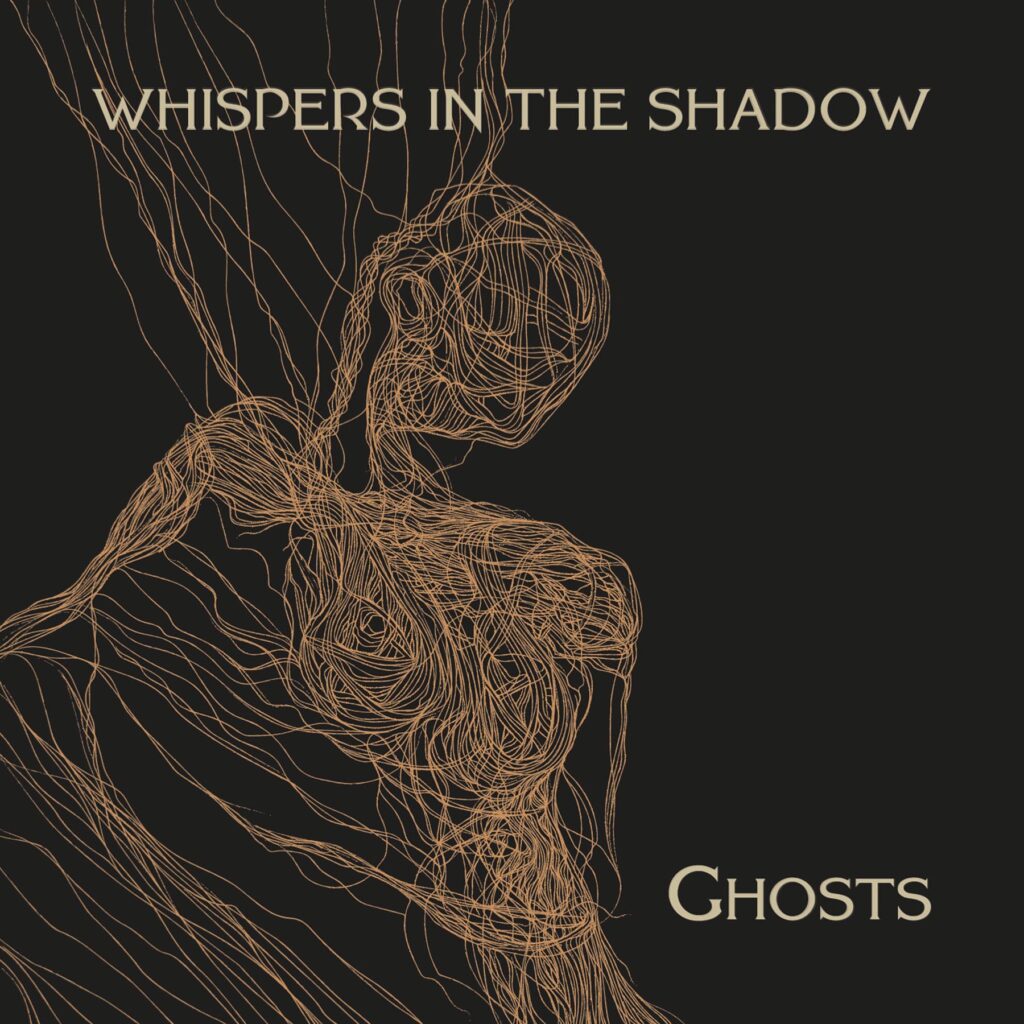
I assume that with ‚Ghosts,‘ you’re referring to spirits in a metaphorical sense. But before we discuss that, let’s take a brief detour because I’m interested in your personal opinion on ghosts in the literal sense. I saw a photo of you on Facebook wearing a t-shirt from the BBC podcast ‚Uncanny,‘ which deals with paranormal phenomena. How do you personally feel about this? Are you Team Skeptic or Team Believer? I love Uncanny, in my opinion, one of the best podcasts out there. Very entertaining, humorous, and exceptionally well-produced. It’s really gaining popularity in England, rightfully so! Well, I’m neither really; I haven’t firmly decided, but I generally lean more towards Team Skeptic. There’s a lot of nonsense in that field, and it’s more like you have to convince me first. My starting point is that of a skeptic. It also depends on the specific case at hand
In the booklet, you quote Libba Bray: ‚Every city is a ghost. New buildings rise upon the bones of the old so that each shiny steel beam, each tower of brick carries within it the memories of what has gone before, an architectural haunting.‘ How should one envision the ghosts of modernity, where can they be found, and how? I believe never before has the present been so enamored with the past as it is nowadays. So, the ghosts are everywhere. In a way, we are all ghost hunters, or we have even become ghosts ourselves, continuously trying to reproduce and relive the past. Apparitions. That’s why the song ‚REVENANTS,‘ which means ‚apparitions‘ or ‚returning ones,‘ revolves around the idea. The lyrics go, ‚We are revenants, haunted by a future that never was“.
Let’s talk about the other kind of ghosts. Can you give some examples of the ghosts that haunt the lyrics? Addictions, paranoia, egomania, fears, and obsessions, and above all, the worst ghost of all, the fear of fear itself. This album is, in many ways, a journey through the abyss. An exploration of personal and collective shadows.
Unlike other WITS albums, GHOSTS is not a concept album. What other themes do you address? I’m not entirely certain if it hasn’t become a concept album after all. Perhaps in a different, not so obvious way. While there isn’t a storyline or a thread running through, in the end, it has become a work that is more self-contained than the last album. Not that it’s a critique of YESTERDAY IS FOREVER, as that album was meant to be a kaleidoscope, each song a cosmos in itself. On GHOSTS, despite the varying instrumentation, the songs come together to create a continuous atmosphere
When we talked about optimism in 2020, you referred to WITS as a ‚fearless band.‘ Yet, on GHOSTS, you also address fear and the fear of fear itself. How do these aspects align? Being fearless doesn’t necessarily mean not having fear, but rather confronting it. Can one truly be fearless without experiencing fear?
Fascinating, I’ve never heard it that way before. Being fearless has always meant not having fear for me, but I’ll let that stand. My personal favorite line from the album is: ‚Stop the press, that’s not the story I want to tell.‘ A relatively simple sentence, yet you sing it with such urgency. And everyone knows the feeling of ending up somewhere completely different from where they planned. Sometimes that’s advantageous, but other times it leads to getting lost or taking the wrong turn. How often did that happen to you during the songwriting of this album? That’s actually one of my favorite passages on the album as well. The songwriting process was quite a challenge this time around. I started a lot of things and then discarded them. Well, I do that all the time, but this time it was somehow tougher. It took a while to figure out how this heavy sound fits within our own universe. And, of course, when you’re changing styles, you need to discover which sounds are necessary, how to write such songs, and so on. There were definitely a few false starts, and I doubted multiple times whether it was a good idea at all. I can’t say I always had fun with it, but that’s not necessarily the point. In the end, the song/album is what matters, and you have to be satisfied with it. But I also don’t want to complain too much; that’s just part of the job, and sometimes it’s easier, and sometimes it’s harder. But of course, we could make it much easier for ourselves, no doubt.
From 2008 to 2014, you released a 4-album occult cycle, and your other band, The Ðevil & The Uñiverse, is also inspired by occultism. Have these themes also made their way into GHOSTS, or do you consider them to be in the past for you? Lyrically, these themes are much more present than on the previous albums, but in a different, less obvious, and perhaps more personal way than before. I now possess different perspectives and experiences that the years in between have brought.
I can tell you’re being rather discreet on that topic. Since we’re on the subject, graphic artist Billy Phobia used the magical technique of Automatic Drawing for the album cover. How can one imagine that? The technique of Automatic Drawing was developed by the Surrealists to express the unconscious and reveal what otherwise remains hidden beneath the surface. The idea is to draw as freely as possible without rational control. The mind is supposed to stay out of it, while the hand leaves behind intuitive and random traces on the paper. It’s drawing from within, free from rules and conventions. Billy created the cover in response to the music, letting the sounds guide him. I’m very pleased with the result and consider it one of the most beautiful and harmonious covers in the band’s history. I’m truly grateful to Billy for it; he has outdone himself.
The centerpiece of the album is the 13-minute-long ‚MAJESTY & TORMENT,‘ a kind of rock opera. You’ve released long songs before, like ‚DOWN BY THE SEA‘ that you mentioned earlier. However, ‚MAJESTY & TORMENT‘ is surprisingly progressive. What were your motivations for writing this song, and why did you choose this format for it? Maybe this song is something like the musical equivalent of Automatic Drawing? Indeed, I can say that this monster of a song simply happened to me. It’s a journey through the abyss and certainly our most progressive song with all its changes in time signature, mood, and tempo. It’s practically the centerpiece of the album. Working on it took a very long time, almost half of the entire songwriting process, come to think of it.
With ‚A HAUNTING,‘ you’ve chosen a single that bridges back to the band’s beginnings while also echoing ‚WALK ON THE MIRROR‘ from ‚YESTERDAY IS FOREVER.‘ However, its calm and atmospheric mood doesn’t necessarily seem representative of the rest of the album. Why did you still decide to release it as a single? Yes, this piece can indeed mislead listeners about the album’s overall tone. Though, ‚GHOST LOOP REMEDY‘ also somewhat follows a similar direction. Similar to ‚WALK ON THE MIRROR,‘ ‚A HAUNTING‘ musically presents a, let’s say, ‚more romantic‘ side that’s rarely found in our music. These kinds of songs are delicate, requiring a certain balance to work. I consider it the most accessible track on the album and probably the only one truly suitable as a single. Thematically, it roughly revolves around addictions, which isn’t exactly a romantic topic, but I found the contrast to be quite beautiful. And since parts of the song are sung from the perspective of the drug, I thought it was fitting. In fact, you could view ‚A HAUNTING‘ thematically as the flip side of ‚WALK ON THE MIRROR,‘ which had a rather idealized approach to that matter. ‚MIRROR‘ is the sunny side, the trip, and ‚A HAUNTING‘ is the hangover and what comes after, what happens when you go down that path for too long.
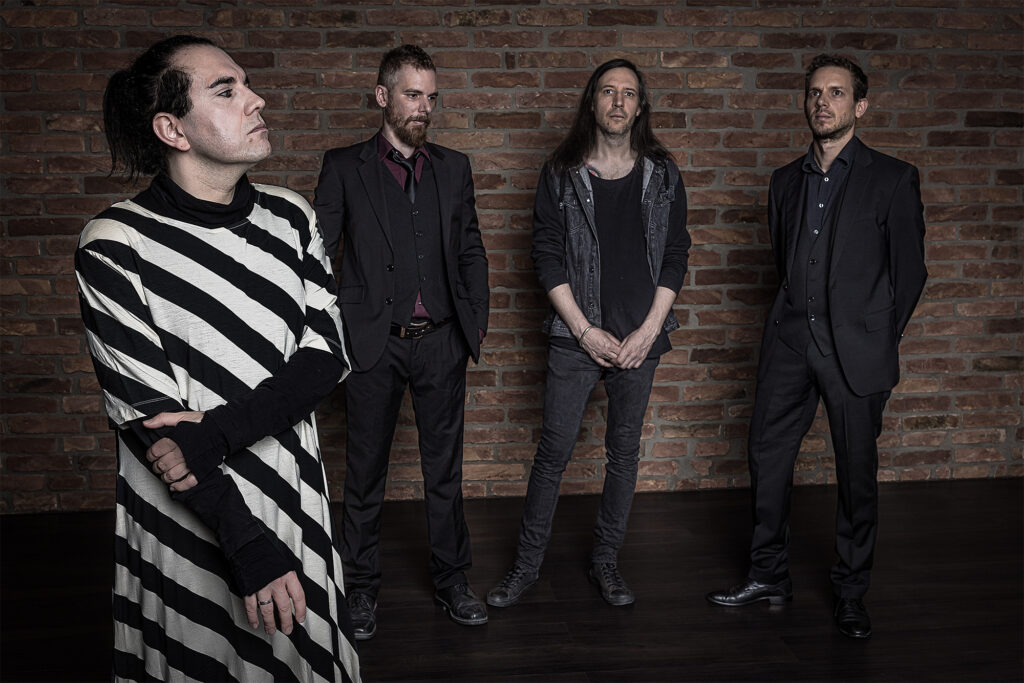
What can you tell us about the creation process of the corresponding one-shot video? A one-shot video had been on our agenda for a while, and ‚A HAUNTING‘ was a perfect fit for it. Additionally, this time we had Andreas Horvath as the cinematographer, who managed to technically execute our ideas just as we had envisioned. In general, the video required a lot of planning in advance, as everyone needed to know exactly what they had to do. Director Edie Calie and I created a storyboard with precisely timed actions. The actual shooting went by quite swiftly. The three actors in morphsuits represent three ghosts: Paranoia, Fear, and Addiction, who chase the protagonist through the woods. But there’s a sort of happy ending. We’ve received a lot of positive feedback for the video, particularly regarding its artistic components
Author Clay McLeod Chapman posted on his social media channels that ‚A HAUNTING‘ was inspired by his book ‚GHOST EATERS.‘ Both the song and the book prominently feature the phrase ‚Let’s get haunted.‘ How should we understand this in this context? It’s indeed a fantastic book, more than just a horror novel, and I highly recommend it. It skillfully addresses themes of addiction and loss. I had been wanting to write a song centered around these themes for a while, but I lacked a suitable and somewhat novel approach. Chapman’s book came along at the right time, as often happens, and provided the necessary push and inspiration for the song’s lyrics and atmosphere. However, I don’t want to reveal too much about what exactly ‚Let’s get haunted‘ means. When you read the book, it becomes quite clear. But everyone is encouraged to form their own thoughts around it.
Lastly, the obligatory question about the future. What does WITS have planned in the near future? We’ve just had a very successful performance at the Amphi Festival in Cologne and our next show is in Rüsselsheim near Frankfurt. We still plan to make at least 2 more albums; I think 13 is a good number. Whether the next one will be the acoustic late-career work permeated with aging grace? I hope not. But as always with us, you can almost never rule anything out.
Bandpicture by Werner Nowak
By GHOSTS under www.SolarLodge.de

